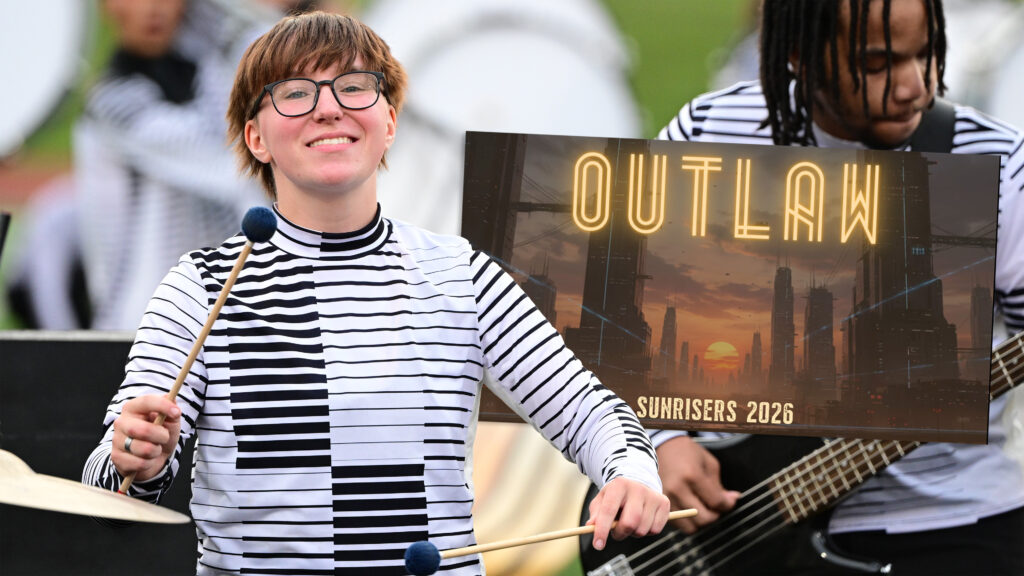Drum Corps International’s 40th anniversary World Championships Week almost got underway on Monday, August 6, 2012, in Michigan City, Indiana.
“Almost” because after the first two corps took the field for the Open Class Prelims, the show had to be interrupted due to a strong thunderstorm that lasted the rest of the day. Consequently, all Open Class corps performed in the Finals competition the next day, with the top 12 in that show being declared finalists.
Oregon Crusaders won the Open Class title by capturing most of the judging captions. The second-place Blue Devils B took the award for Best Percussion while the fourth-place Spartans captured the top honors for Color Guard. The Vanguard Cadets didn’t win any captions despite scoring only a tenth under the Devils and ultimately finishing in third. Other finalists included 7th Regiment, Genesis, Gold, Legends, Music City, Raiders, Revolution, and Colt Cadets.

Blue Devils B took the audience on a thrilling river voyage with its production, “Ecstatic Waters.” Throughout the journey, the corps explored how and where water moved.
The show started with rustling sounds in the front ensemble, leading into the calm and serene introducion from the first movement of Steven Bryant’s 2008 work, “Ecstatic Waters,” performed solely by the front ensemble. Bryant stated the movement “begins as a pure expression of exuberant joy,” evolving “into a full-throated brashness bordering on dangerous arrogance.” The corps’ trumpets were the first brass performers to play, introducing a restrained melody that soon became the joy to which Bryant referred.
Percussionists took turns playing a beat on two extremely deep concert bass drums, adding rhythm to the river’s progression. The color guard’s costumes had strips of blue that were enhanced by sewn-on feathery boa-like strips, giving the impression of bubbling rivulets running over rocks in the river.

Two minutes into the show and the music was still sedate. Though the waters seemed at first to be slow and calm, they soon sped up toward the turbulent end of movement two, “Augurs,” showing that the waters ahead were treacherous.
This short segment led directly into the second movement of John Mackey’s, “Kingfishers Catch Fire,” an energetic 2007 wind ensemble work that was selected because it conveyed the sense of being propelled down a river. Building up to a resolute conclusion, this work ended with a sense that the trip down the river would be one of fun and adventure. But there was yet no sense of any danger of running the rapids.
Although corps arrangers John Meehan, Brian Dinkel, and John Mapes composed the rest of the show, the ballad “Over the Edge” was heavily inspired by Eric Whitacre’s “Mermaids” from the “Pirates of the Caribbean: On Stranger Tides” soundtrack of 2011. According to Meehan, “the haunting melody and mood was perfect for the uneasy feel we were trying to convey.”

Cascading brass chords gave the impression of water rushing over falls as the music became increasingly threatening, leading into a segment where the horns formed a tight block and then manipulated the lines side-to-side to create the impression of water running between narrow crevices of rock.
This led to the entire horn line sequentially turning to the back. A lone horn soloist was left up front, accompanied by rapid arpeggios in the front ensemble that further conveyed the sense of running waters.
The piece ended with the brass players rotating across four arcs toward the front of the field as the color guard performers individually tossed sabers and rifles as if whitecaps riding the crest of the waves. The horns completed the work playing a few ominous and foreboding chords to the backfield.

Blue Devils B’s next piece was a drum solo titled, “Splashdown,” composed entirely by the corps’ arrangers. Once hitting the drum solo, there was no turning back. The horns all but disappeared off the field, relegated to areas near the endzone sidelines. After marching back into the center of the field, the brass players created a drill formation like a cascading waterfall toward the front sideline, bouncing off the front of the field and through the drum line, the drums acting as rocks in the water.
As the drum solo ended, a new calm took over, relaying a sense of triump and survival of the journey the brass players just experienced.
The final work, “River’s End,” was also composed by the three corps arrangers, though there was a recap of “Kingfishers Catch Fire” in the front ensemble percussion section and the brass. Flags brightened with pastel colors, suggesting a rainbow forming over the water after the treacherous journey.
But just as one thought the journey had ended, the brass and drum line members turned to the exit, formed a winding segment of the river, and flowed out the stadium through the back gate. It was said this represented the river flowing throught the gates of a lock, depositing the corps on a new stretch of water where new adventures were waiting.

Michael Boo was a member of the Cavaliers from 1975-1977. He has written about the drum corps activity for more than 35 years and serves as a staff writer for various Drum Corps International projects. Boo has written for numerous other publications and has published an honors-winning book on the history of figure skating. As an accomplished composer, Boo holds a bachelor's degree in music education and a master's degree in music theory and composition. He resides in Chesterton, Indiana.





